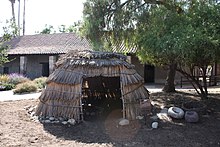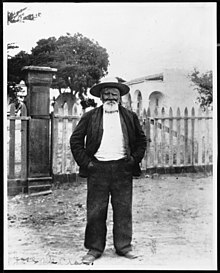
Mission San Juan Capistrano is a Spanish mission in San Juan Capistrano, Orange County, California. Founded November 1, 1776 in colonial Las Californias by Spanish Catholic missionaries of the Franciscan Order, it was named for Saint John of Capistrano. The Spanish Colonial Baroque style church was located in the Alta California province of the Viceroyalty of New Spain. The Mission was founded less than 60 yards from the village of Acjacheme. The Mission was secularized by the Mexican government in 1833, and returned to the Roman Catholic Church by the United States government in 1865. The Mission was damaged over the years by a number of natural disasters, but restoration and renovation efforts date from around 1910. It functions today as a museum.
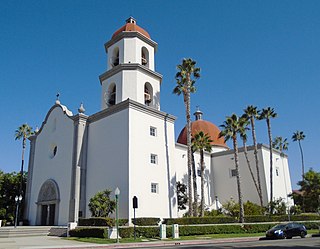
San Juan Capistrano is a city in southern Orange County, California, United States. The population was 35,253 at the 2020 Census. The city is famous for the regular bird migration of cliff swallows to Mission San Juan Capistrano, which is celebrated annually.
Putuidem, alternative spelling Putiidhem or Putuidhem, was a large native village of the Acjachemen people, also known as Juaneño since their relocation to Mission San Juan Capistrano. Putuidem was a mother village, a community that spawned other villages of the tribe.
Chingichngish, also known as Quaoar and by other names including Ouiamot, Tobet and Saor, is an important mythological figure of the Mission Indians of coastal Southern California, a group of Takic-speaking peoples, today divided into the Payómkawichum (Luiseño), Tongva, and Acjachemem (Juaneño) peoples.

Puvunga is an ancient village and sacred site of the Tongva nation, the Indigenous people of the Los Angeles Basin, and the Acjachemen, the Indigenous people of Orange County. The site is now located within California State University, Long Beach and the surrounding area. The Tongva know Puvunga as the "place of emergence" and it is where they believed "their world and their lives began." Puvunga is an important ceremonial site and is the end to an annual pilgrimage for the Tongva, Acjachemen, and Chumash.

Mission Indians are the indigenous peoples of California who lived in Southern California and were forcibly relocated from their traditional dwellings, villages, and homelands to live and work at 15 Franciscan missions in Southern California and the Asistencias and Estancias established between 1796 and 1823 in the Las Californias Province of the Viceroyalty of New Spain.

Gerónimo Boscana was an early 19th-century Franciscan missionary in Spanish Las Californias and Mexican Alta California. He is noted for producing the most detailed ethnographic picture of a Native Californian culture to come out of the missionary period, an account that "for his time and profession, is liberal and enlightened".

The Acjachemen are an Indigenous people of California. Published maps often identify their ancestral lands as extending south of what is known as Aliso Creek and north of the Las Pulgas Canyon in what are now the southern areas of Orange County and the northwestern areas of San Diego County. However, sources also show that Acjachemen people shared sites with other indigenous nations as far north as Puvunga in contemporary Long Beach.

San Juan Creek, also called the San Juan River, is a 29-mile (47 km) long stream in Orange and Riverside Counties, draining a watershed of 133.9 square miles (347 km2). Its mainstem begins in the southern Santa Ana Mountains in the Cleveland National Forest. It winds west and south through San Juan Canyon, and is joined by Arroyo Trabuco as it passes through San Juan Capistrano. It flows into the Pacific Ocean at Doheny State Beach. San Juan Canyon provides a major part of the route for California State Route 74.

Toviscanga was a former Tongva village now located at Mission San Gabriel Arcángel in San Gabriel, California. Alternative spellings for the village include Tobiscanga. The name of Tuvasak was the Payómkawichum name for the village. The village was closely situated to the village of Sibagna.

Cañada Gobernadora is a tributary to San Juan Creek, about 8.5 miles (13.7 km) long, in southern Orange County in the U.S. state of California. The creek begins in the foothills of the Santa Ana Mountains, at an elevation of 1,040 feet (320 m), and flows south through residential, agricultural and finally undeveloped land, to its confluence with San Juan Creek a few miles upstream of the city of San Juan Capistrano. The upper half of the stream is largely channelized and flows through golf courses, while the lower half is a wash-like channel that can be up to 700 feet (210 m) wide. The stream receives some urban runoff from the residential communities higher in its watershed. The watershed includes several geologic formations, including the Tertiary Sespe Formation and Santiago Formation, and Holocene sedimentary and alluvial deposits embedded in its narrow floodplain. Cañada Gobernadora forms an unofficial dividing line for the lower portion of the San Juan watershed; most urban development is confined to west of the creek's valley, while agricultural and undeveloped lands lie to the east of the creek.
The California mission clash of cultures occurred at the Spanish Missions in California during the Spanish Las Californias-New Spain and Mexican Alta California eras of control, with lasting consequences after American statehood. The Missions were religious outposts established by Spanish Catholic Franciscans from 1769 to 1823 for the purpose of protecting Spain's territory by settlements and converting the Californian Native Americans to the Christian religion.
Panhe was one of the largest Acjachemen villages confirmed to be over 9,600 years old and a current sacred, ceremonial, cultural, and burial site for the Acjachemen people. The site of Panhe is now within San Onofre State Beach, San Diego County, California, located at the confluence of San Mateo Creek and Cristianitos Canyon, approximately 3.7 miles (6.0 km) upstream from the Pacific Ocean.
Barbara "Bobbie" Lucille Banda was an American activist who self-identified as a Juaneño tribal elder as a member of the Juaneño Band of Mission Indians, an organization that self-identifies as a Native American tribe but has no federal or state recognition. Banda successfully championed efforts to introduction Native American curriculum, including Juaneño language courses, into the public school systems around San Juan Capistrano, California, during the 1970s. The curriculum is still taught in California public schools today.
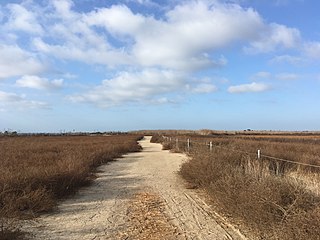
Genga, alternative spelling Gengaa and Kengaa, was a Tongva and Acjachemen village located on Newport Mesa overlooking the Santa Ana River in the Newport Beach and Costa Mesa, California area which included an open site now referred to as Banning Ranch. Archaeological evidence dates the village at over 9,000 years old. Villagers were recorded as Gebit in Spanish Mission records. The village may have been occupied as late as 1829 or 1830.

Alume was a large Acjachemen village located between Trabuco Creek and Tijeras Creek at Rancho Santa Margarita, California. The village was also recorded as Alaugna and as El Trabuco in San Juan Capistrano mission records, and is also referred to as Alauna, Aluna, and Alona.

Piwiva was a Acjachemen village located at the meeting place of the San Juan Creek and Cañada Gobernadora tributary in what is now Rancho Mission Viejo, California. The name for the village was closely related to the Payómkawichum word for wild tobacco piivat. It was located north of Mission San Juan Capistrano, downstream from the village of Huumai and upstream from the village of Sajavit. Alternative names for the village include Pii'iv, Pivits, and Peviva.
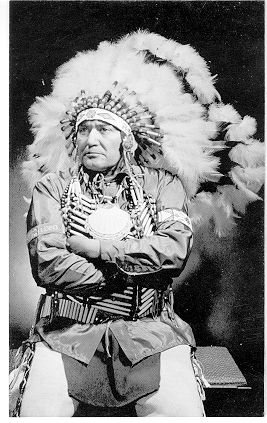
Clarence H. Lobo was the elected spokesperson for the Juaneño Band of Mission Indians, a non-profit organization that self-identifies as a Native American tribe, from 1946 to 1985. He notably made a bid to claim 25 acres of the Cleveland National Forest as an act rejecting the $29.1 Million Dollar offer by the U.S. Federal Government "to settle tribal land claims" in 1964, which valued native land at 47 cents an acre. He opposed the actions of the Bureau of Indian Affairs (BIA).

José de Grácia Cruz was a Acjachemen man who was born in 1848 at Mission San Juan Capistrano. He was known for his work as a bell ringer at the mission, as an artisan, a flutist in a native orchestra that would play at the mission, a sheep shearer, and for his knowledge of the Juaneño language and village sites, including Puvunga. He was also the source of the story of the mission's swallows in St. John O'Sullivan's Capistrano Nights (1930). He was referred to locally as "Acǘ," a nickname that was reportedly given to him as a child by his parents.

Achooykomenga is a former settlement that was located at the site of Mission San Fernando Rey de España before it was founded in 1797. Prior to the mission's founding, in the 1780s, it functioned as a shared native settlement for an agricultural rancho of Pueblo de Los Ángeles that was worked by Ventureño Chumash, Fernandeño (Tongva), and Tataviam laborers.
